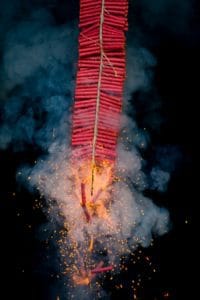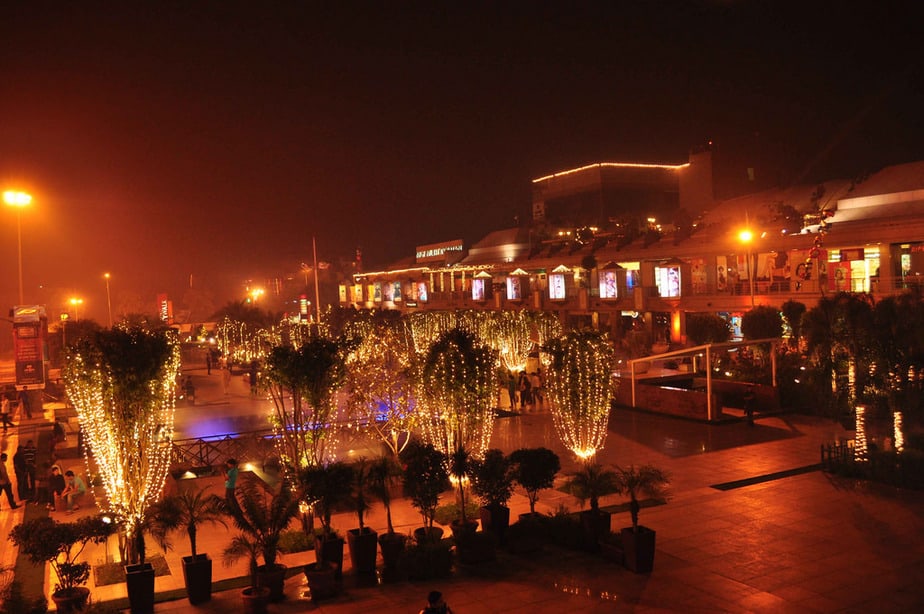The new ruling by the Supreme Court against the complete ban on firecrackers, has been greeted with outrage or relief – and some scepticism.
“Sounds more like a war zone than a puja!” laughs Anita Yadav, resident of a complex building in Sainik Farms. During Dussehra, some of the residents, and neighbours build a small shrine in the parking lot, and make merry for the rest of the night — and quite loudly, much to Yadav’s chagrin.
She has lived in the building for over 10 years now, and the overtly loud celebrations of Dussehra has been consistent over the years. “They bring in these bands, who play well into the wee hours of the night. And constantly burst crackers. And the rest of us lose sleep in the bargain. Sometimes my ears will buzz for hours even after the music has stopped. My mother wears a hearing aid already and she has a heart problem. I can’t imagine that its’ healthy for her to be in this environment.”
If it has been such a menace over the years, why not complain? “Well,” she says, “we did try to speak with the building owner to reach some sort of compromise, but he too celebrates along with everybody else.” She goes on to say that taking the matter to the police would be viewed negatively by the people that conduct the pujas. After all, she would prefer to continue living in that residence in peace rather than as an adversary to the rest of the residents.
The Supreme Court seems to have rushed in where the Yadavs fear to tread — reached a compromise where they allow firecrackers for only two hours on Diwali night and for a little less than an hour on Christmas and New Year’s eve. The judges ruled that only fireworks with reduced emissions and low decibel levels will be allowed, and they can only be sold by licensed vendors, and not online.
The petition was filed by the fathers of three infants, who were concerned for the health of their children due to the constantly deteriorating air quality— and the petition had originally demanded a complete ban on fireworks. The bench consisted of Justice AK Sikri and Justice Ashok Bhushan. The order aimed to reach a balance while still upholding both Article 21 and Article 25, as well as protecting the rights of traders and manufacturers under Article 19(1)(g).
While there is space to appreciate the effort to curb the use of firecrackers, much of it has confused the public. “Allowing it for two hours on one day, considering people will even follow that rule, probably means that exponentially more crackers are going to burnt in a shorter amount of time. How is that a fair compromise?” asks Aakash Raman, 23.
Aakash has not burnt crackers ever since he turned 10. “I read in our Environ-mental Studies class about how they contribute to air and noise pollution — and I didn’t want to be a part of that problem.” In school he was an active member of the Nature Club and was a part of many initiatives within his school circuit. “Moreover,” he continues, “this does not even begin to solve the noise problem!”
Noise pollution can be just as dangerous for health. Typically, it is caused by vehicular traffic, music systems, cleaning appliances and factories. Prolonged noise or noise of very high volume has been deemed detrimental to both mental and physiological health. Constant exposure to noise can have extreme efforts to not only human hearing, but to animals too — so much so that one can even become completely hearing impaired.
Of course, in Delhi everybody is in danger of all of the above. As of last year itself, the noise levels recorded in Anand Vihar, Civil Lines as well as Punjabi Bagh were all well beyond the standards set for these areas, taking into consideration that the standards were determined keeping in mind that they are commercial and residential areas respectively.

Aman Agarwal from Faridabad talks about how loud it gets during Navratri in his neighbourhood. “They block the roads, construct stages and play bhajans all through the night, till at least 3 am, when they reduce the volume a little.” Aman says that the volume was reduced at 3 am after many complaints and much negotiation – “In India, it’s not okay to tell someone to rethink how to celebrate their faith. It’s quite dangerous. So we didn’t persist for too long with the complaints.” Considering that the number of people enjoying the celebrations is always larger than those complaining, one does run a risk when trying to negotiate such things.
Dr Mohan P George from DPCC (Delhi Pollution Control Committee) says that there isn’t any particular time in the year or festival when noise levels are at their highest. This strikes as more worrying since it suggests that the noise levels are perpetually above safe hearing standards, for humans and animals. “The main source of noise pollution is still traffic,” he says. As found by a survey conducted by hearing test app Mimi, which surveilled citizens of over 50 cities across the world, including Delhi and Bombay, Delhi has the maximum number of people with hearing loss proportionate to their age.
Another prominent voice that has been heard following this order, is: “Why are the celebrations of Diwali, Christmas and New Year’s being given this unfair privilege?” The argument stands that there are other festivals too where certain communities burst crackers, and if it is being allowed in moderation on certain festivals of the year, then why not make an allowance for all such festivals?
India has always been a country of celebrations and Delhi being the capital has by default become the hub of all such festivities. It’s no wonder that the noise levels and air pollution are as high as they are. The question is whether or not the authorities plan on strict action against those that deviate from the rules, and whether or not further restrictions will come at any kind of cost.





